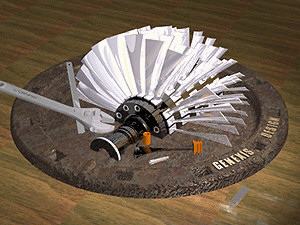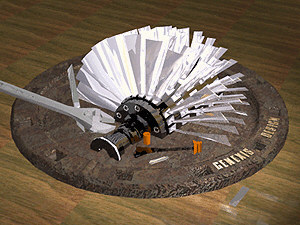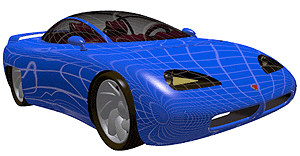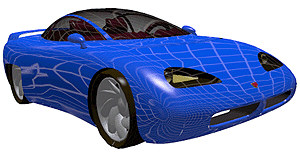| You are here: Home » Specialized Sections |

How to Analyze, Optimize and Reduce CAD & DCC 3D Models Upwards of 80% to 93-99%

How to Analyze, Optimize and Reduce CAD & DCC 3D Models Upwards of 80% to 93-99%
|
Okino's 3D model reduction system comes standard with our industry standard
PolyTrans & NuGraf stand-alone software programs.
You can import/export from all
major 3D CAD/DCC file formats and produce excellent model
compression with resulting high fidelity.
Not only is it 1/2 to 1/10th the cost of other single-purpose polygon reduction programs from
other companies but you also get access to the most refined set of flawless 3D import/export converters on the market, as well as scene manipulation
and dozens of other useful features. The reducer optionally and automatically merges triangles into quads,
if and when possible, to help further reduce the polygon count. It has been in wide spread, high-end 3D industry usage for decades and hence is ultra stable.
Okino's primary focus is to develop mathematically precise CAD & DCC conversion solutions for the automotive, aerospace, military, engineering, corporate and mid- to high-level 3D production markets. A smaller subset of such users have long required a means to bridge the divide between their large source 3D datasets and destination 3D programs which can only handle a smaller fraction of such data. For example, Okino's model optimization tools have become particularly relevant in recent years to Unity and Unreal users in order to provide extreme compression of CAD datasets into light weight models for visualization with Microsoft HoloLens, HTC VIVE, Oculus Rift, Meta and other forthcoming VR headsets. As a real-world example, and with careful consideration of the model's topology + contents, one customer's 3.5 million polygon SolidWorks CAD model was reduced to 200k polygons with only fair degradation by following some of the rules and suggestions outlined in the list below. The polygon reducer, as well as many other 3D mesh processing tools, are accessible via several access points in the software's user interface, as well as during batch conversion of 3D files and via the "Operations" menu of the spreadsheet editor. The core software also includes Okino's completely unique "parts count and hierarchy optimizer" which has formed the "black magic" and most important aspect of our software for decades - this takes ultra complex 3D CAD/DCC models and optimizes them for much faster real-time redraw performance (the optimizer is located in the 'Win' menu of the 'Selector Window'). Few 3D graphics people tend to realize that it is the "node count" of a model and not its polygon count which tends to bog down most DCC/Animation/Authoring packages -- this optimizer, for example, can reduce a model with 250,000 nodes down to a more reasonable and sane 250 nodes ("geometry instances"). It is what allows our software to move super-massive oil & gas platforms into 3ds Max, Maya, Cinema-4D, Unity. etc. An excellent and typical example is this BP Clair Ridge oil & gas rig platform animation done with Okino's CAD conversion and optimization system + process (and these other two similar case studies for the CB&I Oil Refinery and Tesco Corp oil well drilling rig). This node-count optimizer is available, and enabled by default, on most key Okino importers as the "Optimize Hierarchy" checkbox. |
"I work at a Danish advertising agency where we have an inhouse 3D department producing a lot of 3D work for print and animation. I've found the Okino polygon reduction system to be a splendid tool which makes it easy to automate the process of making fantastic good-looking low-res models for animation with Softimage and Maya. We use it to do a lot of LEGO Bionicle visualisations, where we just parent rigid parts to joints, and put the hi-rez/low-rez parts in different display layers." |
Please do not rush to download the Okino demo software to import a CAD model, kick its tires and then move on in case it does not do as you initially expect. We do not work in any such indirect manner with our core user base. Okino is an engineering R&D company for which we work very closely and personally with everyone. On one hand, if you wish to achieve 80% reduction on a typical CAD model then that can be achieved effortlessly by using the default polygon reduction system + options. However, if you have an initial expectation of pushing the envelope to 90%, 95% or even 98-99% reduction then you really need to follow a much more refined and well defined "compression process" as preached by Okino's CTO Robert Lansdale (in extended email discussions). To paraphrase such discussions,
(1) Polygon reduction is NOT the panacea to CAD model reduction, or a magic bullet, as many 3D graphics people commonly believe. It should not be considered the "blind, one stop solution" to instant model reduction. Rather, the process openly preached by Okino involves a deeper understanding of the model on hand and how it should be compressed. As a common example we often refer to in our emails, one pre-sales Cinema-4D customer approached us with a request to do a high poly reduction of his 707 Cockpit model for faster interactive VR viewing; upon review of the model we found that most of the complexity existed in a coiled telephone handset cord and in a hidden spring - it was best that the dials and knobs of the cockpit model remain non-reduced whereas these other useless parts just deleted. More times than not, a model not does need to be poly reduced but rather just intelligently pruned. That's also where Okino's extensive spreadsheet editor (Control-E in the UI) comes into play as it allows such "polygon greedy" portions of a model to be quickly uncovered + optionally reduced or better understood.
(2) You should ideally whittle down the CAD model in the source MCAD program first and/or "shrink wrap" the model. That is something we used to mention often during the 2000s decade when limited memory was more of an issue.
(3) MCAD/Trimmed-NURBS/solids models are not like the common DCC/Animation 3D mesh models that you may often acquire from such sources as TurboSquid, Digimation or even as a lovely skinned mesh character model. MCAD models are often defined as a large number of small sliver triangles in regions defining virtual holes, fillets and chamfers -- that is all the norm in the MCAD world but rarely seen or experienced in the DCC/Animation world. That is a key concept to keep firmly in mind when doing severe compression on MCAD models.
(3b) Likewise, virtual "holes" in a CAD model can sometimes be a hindrance to retain near-perfect quality of a reduced model while pushing 85-90-95-99% reduction. That is because these MCAD models need a large number of these tiny sliver triangles in order to simulate trimmed regions or "holes". Hence, in the ideal world, try to edit out these holes or voids in the source MCAD program. Many of your problems will instantly go away when trying to do extreme reductions.
(4) You should never blindly poly reduce any CAD model -- nothing is more important to consider for a high quality CAD model reduction. Rather, you need to acquire a "good, intimate feeling and understanding" of your CAD model. For example, a mostly-flat sheet metal portion of a model might not be poly reduced at all, whereas you'd probably want to group "important visible geometry" so that Okino's special "geometric tolerance polygon reduction method" can be used on that portion of the model.
(5) When people first approach us via email they will most often, implicitly or explicitly, ask for and expect 98% to 99% reduction at the "push of a button". While that is often technically possible, it is generally not possible to achieve 85-90-95-99% reduction with a simple push-of-a-button. At the end of the day it all depends on the geometry topology of the source mesh model (or "how nice" the mesh tessellation of the source CAD/MCAD model is). Our own daily experience, over the decades, has shown that we can often achieve 98-99% reduction on many CAD-centric models when using our "geometric tolerance polygon reduction method". If you wish to just run the reducer with its default options (80% reduction), on any generic model, then you will most likely be able to achieve an immediate and good quality 50-80% reduction (which can be considered the simpler "push button method").
(5b) In general terms, you can get much higher compression with the "geometric error tolerance reduction method" and by segmenting your CAD model so that varying levels of reduction (or no reduction) are applied to each segment. Also, a quick review of the model in Okino's spreadsheet editor (Control-E from the keyboard) will most often uncover small or non-important parts of the model that consume large numbers of polygons, which otherwise could easily be deleted rather than polygon reduced.If you would like to push the envelope on a CAD model reduction process then the best, initial approach (during your evaluation process) is to send such a model to Okino's Robert Lansdale for a quick review and expert-level commenting. A model can often be compressed much better if there is a good understanding of the model on hand and the proper approach to take for its reduction (ie. refer to the '707 Cockpit' example mentioned above).
The Okino polygon reduction system is a mechanism that can greatly reduce the number of polygons in one or more 3D objects of a scene without greatly sacrificing object quality. It is a vital polygon optimization tool of the Okino PolyTrans and NuGraf software packages, which is included for free as part of the base level Okino software packages.
If you are a Maya or 3ds Max user and wish to utilize the polygon reduction system, first export out an Okino .bdf file using the special PolyTrans-for-Maya or PolyTrans-for-3dsMax plug-in systems, load that file into the stand-alone PolyTrans or NuGraf programs, perform the reduction, re-save the Okino .bdf file and re-load it into Maya or 3ds Max. There will be no geometry data loss in the process.
If a 3D model has a sufficient number of polygons in it then typical reductions are 80% to 95% while retaining good visual fidelity. The Okino polygon reduction algorithm implementation is based on the quadric error metrics (QEM) technique. This technique tries to retain the quality and appearance of the original model while reducing the overall number of polygons.
The following images show example polygon reduction results. The same applied techniques are outlined in the polygon reduction tutorials.
Original, 86154 triangles
80% reduction, 17143 triangles
The polygon reduction system is described in several sections and online tutorials:
A Very Quick Overview of the Okino Polygon Reduction Algorithm
Polygon Reduction Tutorials
Step by Step Guide to Achieving Good Polygon Reduction
Hints and Tips for Using the Polygon Reduction Algorithm
FAQ's (Frequently Asked Questions)
Limitations and Gottchas
Dialog Box Option Descriptions
How to Execute from within PolyTrans or NuGraf:
- Method 1: Right click on any instance shown in the Selector window and click on the "Polygon Reduction" pop-up menu item. This will allow a single geometry instance to be reduced or all instance children of a chosen grouping node.
- Method 2: From the Geometry main menu, select the "Polygon Reduction" option and then the "Reduce all objects in scene" sub-menu item. This will apply polygon reduction to every object defined in the scene.
- Method 3: While in instance select mode (and not polygon select mode), select one or more instances in the Selector window. From the Geometry main menu, select the "Polygon Reduction" option and then the "Reduce selected instances" sub-menu item. This will apply polygon reduction to only the instances currently selected.
- Method 4: Right click over top of any instance (object definition) shown in one of the 3D view windows and click on the "Polygon Reduction" pop-up menu item. This will apply polygon reduction to that single instance.
- Method 5: Start up the scene spreadsheet editor by pressing Control-E within the Okino stand-alone PolyTrans or NuGraf software. This is a core "go to" tool in Okino software when dealing with scene compression and reduction. We use it all the time to acquire the "pulse" on a newly imported CAD file and also to determine where attention is needed. You will select (highlight) one or more lines on the Geometry spreadsheet panel then choose "Polygon Reduction" from the "Operations" pop-up combo box. Many other operations have been made available for use in this manner. You can also export out all or some of the panels to Excel or a CVS file for further data review. The Okino spreadsheet editor is heavily documented in the software's help file.
Basic Parameters to Set:
To reduce the number of polygons in a model set you will typically change the "Polygon Reduction Amount" slider to select the desired percentage of reduction, then press the "Reduce!" button. After the model has been reduced press the "Exit" button to return to the main application.
When to Use
Use this algorithm any time you wish to reduce the number of polygons in a scene while retaining similar object quality and appearance. For example, you may have imported a CAD model with 1 million polygons which renders much too slowly; polygon reduction might bring this number down to 50,000 polygons with similar visual results after rendering. In general, any time you need to reduce the number of polygons in a scene then try using this algorithm - please read the tutorials so that you understand how to achieve the best possible quality.
"Turbine on a Plate" model created and copyright by Genexis Design of Toronto, Canada. The "Blue Car" model created by Gary Morales using CDRS software, an Evans and Sutherland product.





